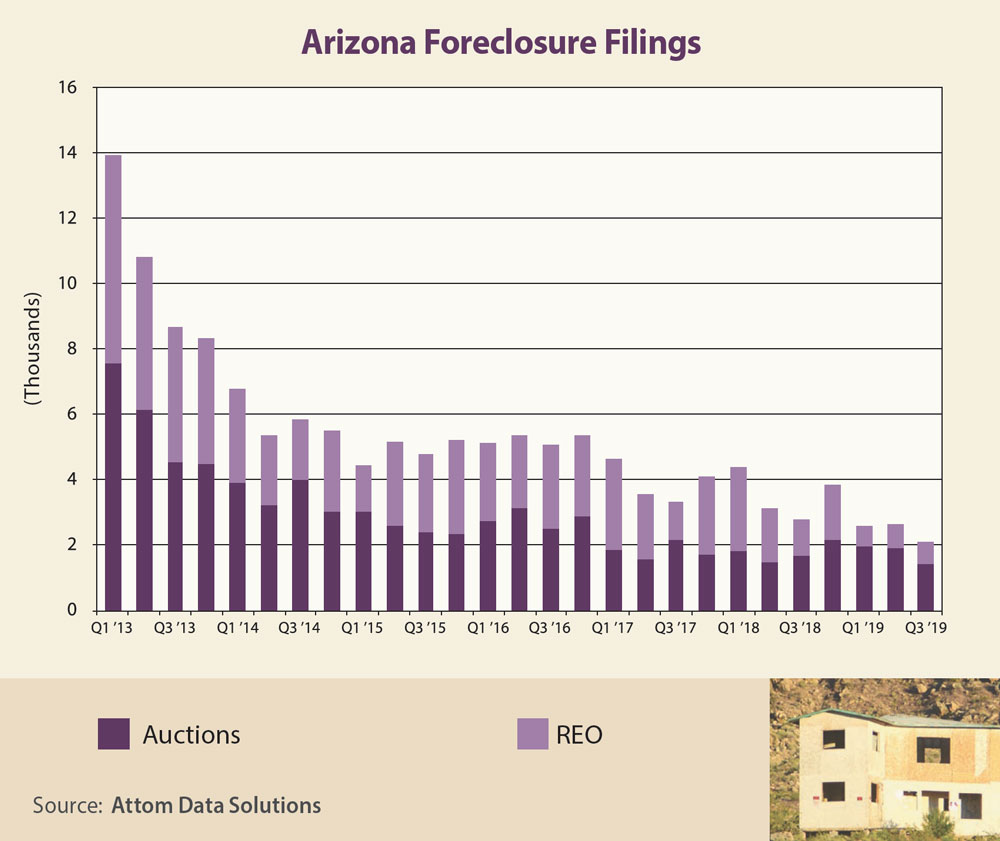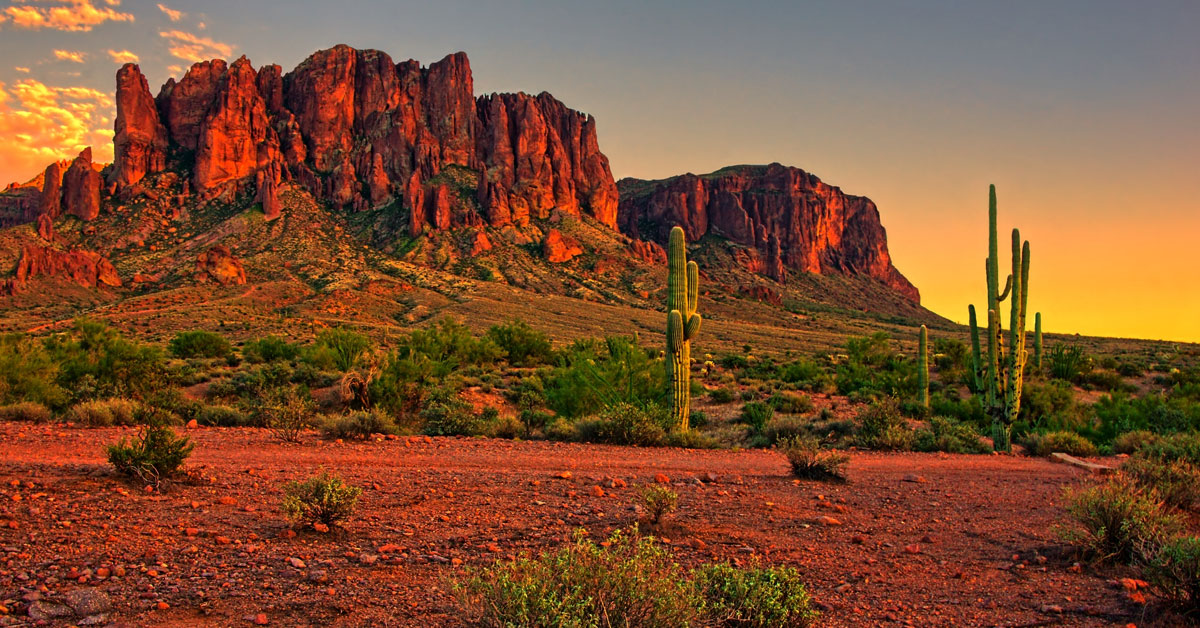Along with California, Florida and Nevada, Arizona is one of the so-called “Sand States.” These states feature large deserts or beaches and saw huge home-price gains before the Great Recession, then suffered acutely during it. These four states accounted for 40% of all U.S. mortgage-foreclosure starts in 2008. In fourth-quarter 2008, for example, foreclosure sales accounted for 65% of all homes sold in the Phoenix area.
The Grand Canyon State has bounced back nicely, however. Since 2010, Arizona has ranked eighth in the nation with a population-growth percentage of 13.5%, according to the World Population Review. About 2 million people have moved to the state in the past 20 years, with the population growing from 5.1 million in 2000 to 7.2 million last year, or an increase of about 40%.
Much of the growth is occurring around the two largest cities, Phoenix and Tucson. Maricopa County, which includes Phoenix, was the fastest-growing county in the nation for a third straight year in 2018, the U.S. Census Bureau reported. Census data also shows that 68% of Arizona residents weren’t born in the state.
The Grand Canyon State has long had a reputation for attracting retirees, who require health care and other services. Five of the top 20 largest employers in the state are hospitals or health care-related businesses. Arizona also is a top-five player in the U.S. for aerospace and defense manufacturing. Defense contractor Raytheon employs 12,000 in the state and Honeywell employs another 7,800.
Mining also has been a major economic driver for the state. The mining industry employs about 10,000 people statewide and produced roughly $6 billion in direct economic output in 2017, according to the Arizona Mining Association. The state produces a mix of gold, silver and uranium, as well as 65% of all copper produced in the U.S., the association reported.
Arizona ranks third in the U.S. for cumulative solar capacity and is capable of producing nearly 3,900 megawatts of energy, or enough to power 572,456 homes, according to the Solar Energy Industries Association. Voters rejected a measure last year that would have required the state’s utilities to draw 50% of electricity from solar and other renewable sources by 2030.
More than 86% of the state’s residents have a high school degree, while about 28% have attained a bachelor’s degree or higher. Arizona’s median household income in 2017 was $56,581, which ranked 29th in the nation, according to the Kaiser Family Foundation. About 14% of Arizonans are considered to be living in poverty.
Home sales and prices
The low point for the Arizona housing market was in 2012, according to real estate data provider Zillow. Prices dipped after the recession until the median price for a single-family home in the Grand Canyon State reached $125,000 in 2012. Since then, however, median prices have steadily climbed. From January through September of this year, the median price for an Arizona home reached nearly $250,000, or about double what it was seven years earlier.

Oddly, the number of closed sales each year has stayed roughly the same since 2012. Each year, the state has seen between 155,000 and 182,000 home sales.
The short-term rental market is thriving in Arizona with two of the top 10 markets in the U.S. in the Grand Canyon State, according to Realtor.com. Scottsdale is No. 1 on the list and Tucson is No. 10. People who use Airbnb and other short-term rental websites head to Arizona for baseball spring training and other events, as well as sun, swimming pools and to take in the state’s natural beauty.
What the locals say
“Obviously, the cost of living (in Arizona) is attractive and it’s one of the reasons why so many people, particularly from California, are moving here. … (A lot of the population growth also is) coming from the Midwest. We’re seeing a ton of people from Minnesota, a ton of people from Chicago, Detroit, Cleveland. You see there’s Cleveland Indians bars popping up, Iowa Hawkeyes bars.”
 Ross Greenberg
Ross Greenberg
Real estate agent, Local Board Real Estate
Unemployment
Arizona’s unemployment rate remains higher than the rest of the country. The state had a 4.9% jobless rate this past September. That compares with 3.5% for the U.S. during the same month. During the recession, Arizona recorded 17 straight months with double-digit unemployment — from July 2009 through November 2010. The U.S. as a whole recorded only a single month during that time in which unemployment rose to double digits.
The Grand Canyon State received some good news on the jobs front, however. Personal-finance website Kiplinger forecast that Arizona will tie for fifth in job growth in 2020, with a projected addition of 50,400 new jobs. Kiplinger noted that the Mayo Clinic is investing $650 million in a major expansion in Phoenix, while Caterpillar’s surface mining and technology division is building a new headquarters in Tucson. Rosemont Mine wants to construct a copper mine for $2 billion that could generate 2,500 new jobs near Tucson. And Raytheon announced plans to add 1,000 jobs in the Tucson area.
Delinquencies and foreclosures
Arizona’s mortgage-delinquency rate, defined as loans 30 days or more past due, was 2.6% as of July 2019, according to CoreLogic’s Loan Performance Insights Report. That’s down 0.2 percentage points compared to the same month in 2018. The national rate for July 2019 was 3.8%. Arizona’s foreclosure rate stood at 0.2% this past July, unchanged from a year earlier, while the nationwide foreclosure rate at that time was 0.4%, according to CoreLogic.

The number of foreclosure filings — as measured by auctions and real estate-owned (REO) properties — totaled 14,149 last year, according to Attom Data Solutions. In 2013, 41,731 homes were in some form of foreclosure.
3 Cities to Watch
Phoenix
Arizona’s largest city, with 4.9 million metro-area residents, also is the state capital. Its economy was once dominated by ranching and farming, but it has since developed into one reliant on services, technology and tourism. The largest employers in the city include state and local government, Banner Health, and a mix of large banks and retailers. Arizona State University, in the nearby suburb of Tempe, is another major employer. Although Phoenix has been the center of much of the state’s population growth, it also has been called the least sustainable city in the world because drought is an ever-present concern.
Tucson

People have been living in the area that is now Tucson for thousands of years — first the Hohokam Indians and then, in the 1600s, Spanish missionaries and soldiers. Located in the southern portion of the state, Tucson is now its second largest city with about 545,000 residents. Defense contractor Raytheon and the University of Arizona are two of the community’s largest employers. The city’s median household income is $39,617, which lags behind the rest of the state and the nation.
Morenci
This town in southeast Arizona is home to the largest copper mine in North America and produces about 575,000 tons of the metal each year. Along with Bagdad, Morenci is one of two active company towns in Arizona. Freeport-McMoRan operates the mine and most of the businesses in the town. Morenci was originally named “Joy Camp” when copper was discovered there in the 1870s. Morenci is in Greenlee County, which has a population of 9,500 and a median household income of about $56,300, according to census figures.
Sources: Arizona Mining Association, Arizona’s Economy, Attom Data Solutions, Business Insider, CoreLogic, Federal Deposit Insurance Corp., Encyclopedia Brittanica, Inside Tucson Business, Kaiser Family Foundation, Kiplinger, KJZZ, Phoenix Business Journal, Solar Energy Industries Association, The Arizona Republic, U.S. Bureau of Labor Statistics, U.S. Census Bureau, Western Mining History, World Population Review, Zillow







